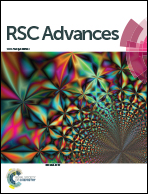Selective colorimetric and ratiometric probe for Ni(ii) in quinoxaline matrix with the single crystal X-ray structure†
Abstract
A quinoxaline based colorimetric nickel sensor, HQAP [2-(quinoxalin-2-ylmethyleneamine)phenol] with high selectivity and sensitivity toward Ni2+ ions is shown to have potential for practical use. The absorption maximum of HQAP shows a large ratiometric shift from 306 to 570 nm (ΔI = 264 nm) in the presence of Ni2+ ions, and the color changes from colorless to deep violet only upon addition of Ni2+ which is very easily observed by the naked eye (the detection limit of Ni2+ is as low as 4.16 μM in solution). The predicted binding mode (2 : 1) from spectral analysis and Job's plot was confirmed by the single crystal X-ray structure of the complex.


 Please wait while we load your content...
Please wait while we load your content...